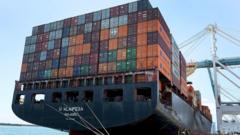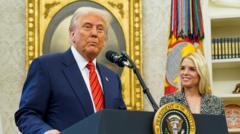The World Trade Organization has revised its forecasts, predicting a decrease in global trade this year as a direct result of tariffs imposed by the US. Concerns about reciprocal tariffs and political instability further aggravate the situation, especially in North America.
WTO Predicts Drop in Global Trade Amid US Tariffs

WTO Predicts Drop in Global Trade Amid US Tariffs
World Trade Organization warns of significant decline in global goods trade due to US tariffs, with North America facing the steepest drop.
The World Trade Organization (WTO) has issued a stark warning regarding a projected decrease in global trade in 2023, attributing this downturn to tariffs imposed by US President Donald Trump. The organization has flagged "severe downside risks," including retaliatory tariffs and escalating political tensions, which could exacerbate the decline in global goods trade. The report highlights that North America is anticipated to experience the most drastic decline, with a forecasted drop of over 10%.
Ngozi Okonjo-Iweala, the WTO's Director-General, expressed her concern over the "decoupling" of the US and China, describing it as a “phenomenon that is really worrying.” Initially, the WTO had predicted a 2.7% growth in global goods trade by 2025; however, the revised forecast now indicates a potential contraction of 0.2%.
Chief economist Ralph Ossa emphasized that tariffs are a policy tool that often yields unintended consequences, asserting that trade policy uncertainty markedly dampens trade flows, resulting in reduced exports and weaker economic performance. The baseline tariff of 10% applied to nearly all foreign imports to the US commenced on April 5, although certain countries and products are exempt. Notably, China faces much steeper tariffs, now totaling 145% on most goods.
On the stock market front, US indices experienced a decline at opening on Wednesday amidst lingering uncertainty. Despite the dark outlook for US-related trade, the WTO's report suggests that trade growth in regions such as Asia and Europe may remain modest for the year.
Interestingly, the report also marks the first instance of forecasts addressing services trade, which encompasses the exchange of services in sectors like tourism and finance, as opposed to tangible goods. The WTO anticipates a 4% growth in services trade by 2025, representing a decrease of one percentage point from earlier projections.
Trump's tariff strategies have been characterized by fluctuations and reversals since his inauguration in January. The President has claimed that these import taxes will stimulate domestic consumption of American-made goods, enhance tax revenues, and attract substantial investment. However, critics argue that revitalizing manufacturing in the US is a complex process that could take decades, raising concerns about economic struggles in the interim. After initially imposing steep tariffs on around 60 trading partners, Trump later called for a 90-day halt, excluding China, amid mounting criticism from politicians and market analysts.
Additional commentary from the Bank of England's governor in March indicated that Trump's tariffs could ultimately reduce disposable income for consumers in the UK, highlighting the broader implications of the tariff policies on international trade dynamics.




















